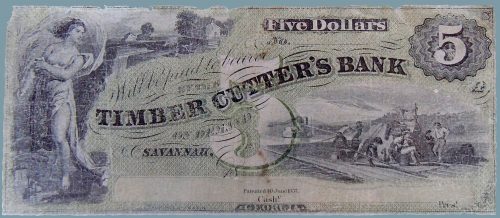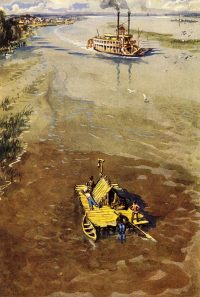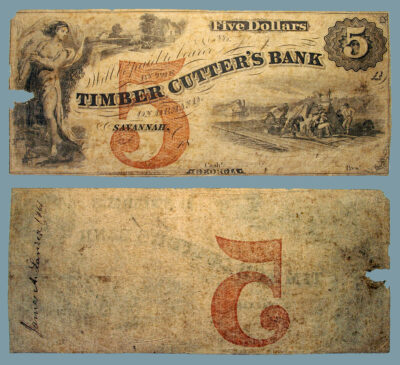P007
$5 Paper Currency, Fine, ragged top edge
17.5 cm x 7.5 cm (6-7/8” x 2-7/8”)
HISTORY: The quality of this beautiful pre-Civil War currency is in Fine condition, bucolic in the southern themes of its time. That said, let the history begin.
Savannah is the oldest city in Georgia, established in 1733 and located along the shores of what is now the Savannah River. It soon became an important shipping port destination for both import and export goods. By the 1850s, slavery was Savannah’s largest domestic, nonexport industry. Timber Cutter’s Bank (TCB) was formed, I believe, in June 1857, when this bill was issued. H.W. Hollister was president of the bank with J.S. Hutton as cashier. The bank was located on the corner of Perry and Jefferson Streets (which is a parking lot today), inside the City Market area where banks and brokers traded slaves. TCB ceased business activities prior to the capture of Savannah on December 21, 1864, by the Union Army’s General William Sherman (1820–1891).
OBVERSE: North Georgia begins in the Blue Ridge Mountains, the origin of many streams and rivers. These rivers flow across the central Piedmont plateau region onto the foothill fall-zone escarpment, down to the coastal plains in the south. As a result, Georgia is resplendent in an abundance of waterfalls. Pictured in the upper left is a bucolic vista with a river flowing over one of those falls. Demeter, Roman goddess of agriculture and earth, glances over her left shoulder at the pastoral scene.
Opposite is a vignette along the Savannah River, a riverboat in the distance, and a crew of raftsmen in the foreground, a common scene at the time. The “5” in the center is transparent in this printing. I have also have this bill with a solid “5” off-centered to the left (Detail 1).
This bill has not been signed or numbered, so it was obviously never issued. At the bottom of the bill, to the left of “GEORGIA,” though hardly legible, are the words “BALD, COUSLAND & CO. PHILADa & NEW YORK.” Bald formed in 1853 as engravers of currency, stamps, and stock certificates. By 1860, they were merged, along with a number of other independent printers, into the American Bank Note Company, which began printing TCB’s currency in their final years.
REVERSE: Blank.




